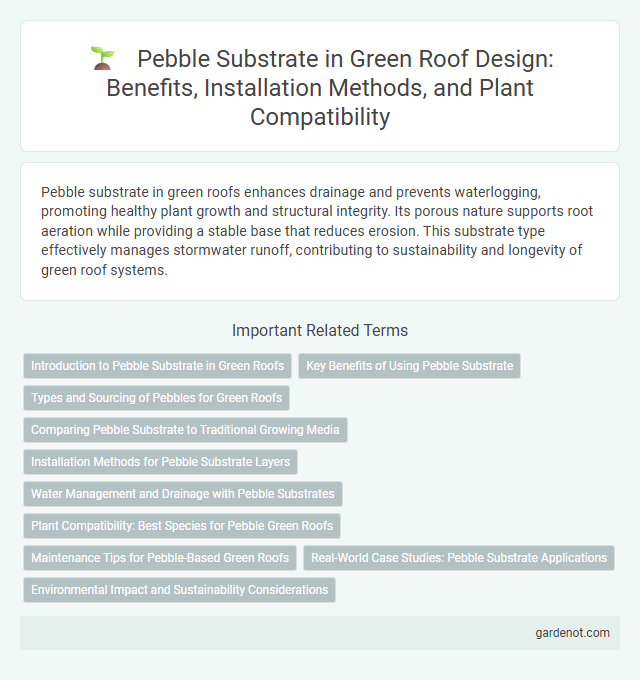Pebble substrate in green roofs enhances drainage and prevents waterlogging, promoting healthy plant growth and structural integrity. Its porous nature supports root aeration while providing a stable base that reduces erosion. This substrate type effectively manages stormwater runoff, contributing to sustainability and longevity of green roof systems.
Introduction to Pebble Substrate in Green Roofs
Pebble substrate in green roofs provides excellent drainage and aeration, supporting healthy plant root systems by preventing waterlogging and promoting oxygen flow. Its durability and resistance to compaction ensure long-term stability and structural integrity of the green roof layers. This lightweight, permeable material also enhances stormwater management by facilitating efficient water runoff and retention within the roof assembly.
Key Benefits of Using Pebble Substrate
Pebble substrate offers superior drainage and aeration for green roofs, preventing waterlogging and promoting healthy root growth. Its durability and stability provide a long-lasting medium that supports plant life while resisting erosion. Additionally, pebble substrate improves thermal insulation, contributing to energy efficiency in buildings with green roofs.
Types and Sourcing of Pebbles for Green Roofs
Pebble substrate for green roofs primarily includes types such as river pebbles, granite, and basalt, chosen for their durability, porosity, and aesthetic appeal. Sourcing pebbles locally reduces transportation emissions and supports sustainable practices while ensuring compatibility with the regional climate and plant species. High-quality pebbles contribute to effective drainage, weed suppression, and thermal regulation on green roofs, making careful selection essential for long-term performance.
Comparing Pebble Substrate to Traditional Growing Media
Pebble substrate offers superior drainage and aeration compared to traditional growing media like soil or compost, reducing root rot and waterlogging risks in green roof systems. Lightweight and inert, pebbles maintain structural integrity and minimize substrate compaction, enhancing long-term plant health and roof stability. Unlike organic media, pebble substrates provide a durable, maintenance-friendly option that supports efficient water flow and nutrient retention without degrading over time.
Installation Methods for Pebble Substrate Layers
Installing pebble substrate layers on green roofs involves first laying a geotextile fabric to prevent substrate loss and improve drainage. Pebbles are evenly spread across the surface, creating a stable, porous layer that enhances water filtration and root protection. Proper compaction and grade adjustments ensure effective water runoff and substrate stability for long-term green roof performance.
Water Management and Drainage with Pebble Substrates
Pebble substrates enhance green roof water management by facilitating efficient drainage and preventing water accumulation that could damage roofing materials. Their high porosity and permeability allow excess rainwater to quickly flow through while retaining sufficient moisture for plant roots, balancing hydration and runoff control. Using pebble substrates reduces the risk of waterlogging and promotes healthier vegetation, contributing to sustainable green roof ecosystems.
Plant Compatibility: Best Species for Pebble Green Roofs
Pebble substrates on green roofs provide excellent drainage and aeration, making them ideal for drought-tolerant and shallow-rooted plants. Succulents such as Sedum species and Sempervivum thrive due to their minimal water requirements and adaptability to harsh conditions. Other compatible plants include drought-resistant herbs like thyme and lavender, which benefit from the well-draining properties of pebble substrates.
Maintenance Tips for Pebble-Based Green Roofs
Pebble substrates on green roofs require regular inspection to prevent clogging and ensure proper drainage, which maintains plant health and structural integrity. Removing debris and managing weed growth are essential to avoid root competition and substrate compaction. Periodic rinsing of pebbles helps reduce salt accumulation, preserving the substrate's permeability and supporting sustainable roof performance.
Real-World Case Studies: Pebble Substrate Applications
Pebble substrates have been effectively applied in green roof systems to enhance drainage and root aeration, as demonstrated in urban projects like the Chicago City Hall green roof, where pebble layers contributed to stormwater management and plant health. Studies from the University of Toronto emphasize that pebble substrates improve water retention while preventing soil compaction, leading to increased longevity of vegetation. Real-world installations confirm that using pebble substrates reduces maintenance costs and supports diverse plant species in metropolitan green roof environments.
Environmental Impact and Sustainability Considerations
Pebble substrates in green roofs enhance environmental sustainability by promoting natural water filtration and reducing stormwater runoff, which mitigates urban flooding. Their inert composition minimizes chemical leaching, preserving soil and water quality for extended periods. This substrate choice also supports long-term structural stability and reduces maintenance frequency, contributing to the overall eco-efficiency of green roofing systems.
Pebble substrate Infographic

 gardenot.com
gardenot.com